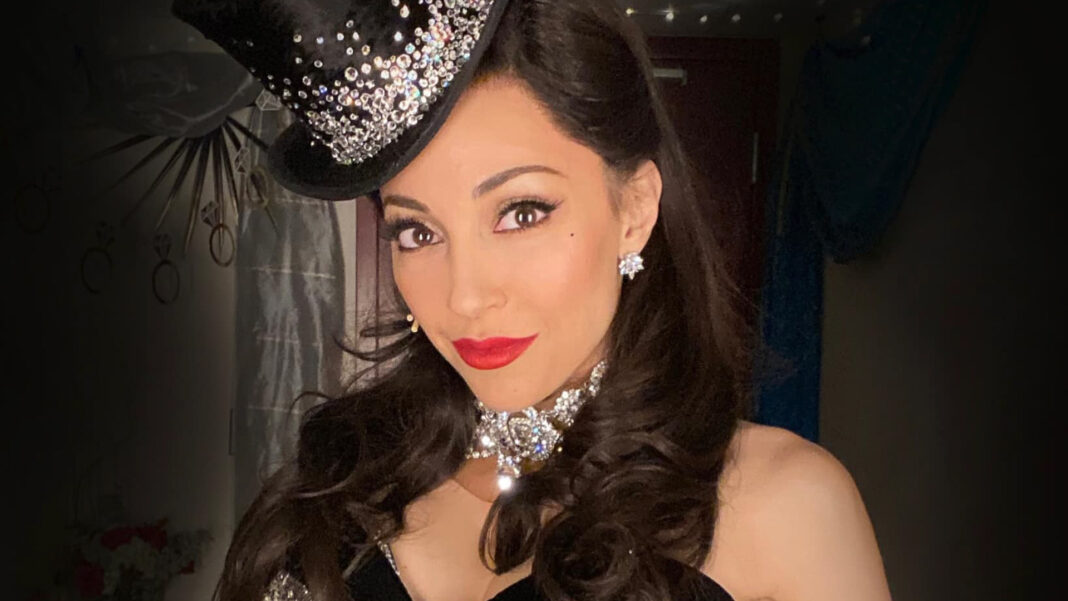
“I remember seeing the movie and falling in love with everything about it. As a musician and songwriter I remember being blown away by the orchestration. It was so exciting to experience that blending of musical genres and visually it was one of the most epic things I had ever seen on the screen.” That’s how Yvette Gonzalez-Nacer remembers her first reaction when she saw Baz Luhrmann’s film Moulin Rouge.
Now she’s on tour performing the role made famous by Nicole Kidman in the film: Satine. Though she isn’t doing the part every night. Gonzalez-Nacer is billed as Satine Alternate in the production that is currently playing through September 4th at the Pantages Theatre in Hollywood.
She was on Broadway as one of the original Fates in the musical Hadestown. This is not her first tour. She performed the role of Vanessa in Lin-Manuel Miranda’s In the Heights around the country.
When she and I spoke the day after I saw her performance in Moulin Rouge, the first thing we discussed was the difference between an understudy and an alternate. What follows are excerpts from our conversation that have been edited for length and clarity. To see the complete interview with Gonzalez-Nacer, please go to our YouTube channel.
Q: Simply put. What does the title of Satine Alternate really mean?
My job is very interesting and it’s my first time doing anything like this. I perform the role of Satine once a week and then more if they need me. So it’s different than an understudy where you basically go on if they need you or a standby. So this is a guaranteed performance weekly.
So how do you keep your physical and mental muscles ready for that? This is a very tightly choreographed and directed show.
I rehearse myself a few times a week. I’ll just go down to a rehearsal room if there is one available and I’ll sing through the whole show. I’ll sit with some of the scenes and, like any project, you want to try and get deeper. Just because you’ve done it and you know what the blocking is and what the songs are, to me the work is never over. I’m always trying to find ways to go further. It’s just about rehearsing on the side and staying in shape physically. Then the day of I have my little personal cram session where I’ll just review the show real quick to get in the state of the show.
The show is impossible to resist and I credit the cast and crew for making Moulin Rouge the Musical so entertaining. But honestly, how challenging is this show to do?

I think we could all agree it’s a beast of a show. There’s so much movement. It’s non-stop. A lot of times when you’re on stage you’re doing things that are challenging on the body. Also vocally, especially for the Christian and the Satines, it’s a lot. So I feel like everyone has their own process to stay healthy.
For me I’ll have to stretch. I have to do cardio just to stay on my game. You take your vitamins and you make sure to rest when you need to rest. That’s so important. Everyone’s so different and it definitely requires taking care of yourself.
Recently understudies and swing performers are getting some long overdue attention. They are truly the unsung heroes in plays and musicals. Do you think this attention will lead to opportunities that they might not otherwise have?
Everyone’s amazing. Everyone’s a fantastic performer. If you got the part or [are] even an understudy, you still have to be at a certain level to even do that. I think there’s this delineation between who has the part and if you are anything else. I wish that would just go away.
It’s a challenging position to not perform every night and then to have to. Some people have to learn nine roles. It’s just the most amazing thing. So I think it’s great that everyone’s getting credit. I just wish that those titles would go away a little bit, just acknowledge the performer and not so much the position that they hold.This is another amazing performer and they happen to be the understudy or they happen to be an alternate.
As Satine, you play a courtesan whose job is to make men feel that she is in love with them. That’s part of her seductive power to get what she needs and, in this case, to keep the club afloat. What are the challenges for you as an actor, having three different Christians that you might be working with on any given night knowing that they all approach their character differently?
It’s an interesting challenge, but it’s also a gift in a way. I’m not the kind of actor who wants to memorize a performance. There’s nothing wrong with those kind of actors. This is not what I find exciting. So when you have a different Christian you have to be present. You’re forced to pay attention. You’re forced to learn them for the first time and be curious about them and be affected by them as it’s happening.
In Baz Luhrmann’s movie the role of Satine was played by Nicole Kidman, who could not have been more porcelain white. The first person cast on Broadway was Karen Olivo who is Puerto Rican, Native American, Dominican and Chinese. As a Cuban-American who gets to also play this part ,how important is it that the producers did not try to find a Nicole Kidman-type actor and were open to a different way of approaching the role?
It’s always a joy for me and a privilege to be able to represent my Cuban heritage. Diversity and inclusion is such an ongoing conversation. I’m glad to see Broadway in general changing. Obviously it’s not going to change overnight, but I feel like these baby steps towards inclusion and diversity are so important and they’re so exciting. To be even a small part of that is also exciting.
I have a theory that the greatest love stories that stand the test of time are those in which the couple does not end up together. I’m talking about dramatic love stories. Romantic comedies are a separate thing altogether. Why do you think we respond to stories like that?

Love and life is this endless dichotomy. We know our time here is limited. Nothing’s guaranteed. But we also know that even when a relationship ends, whether it’s a breakup or a death, the people we love always end up living inside us in some way. If we hold a memory of them they can still be with us and guide us like the stars.
I think we love to see this on stage and on screen – the idea that love can somehow still last forever if we let it. That it’s still worthwhile even though we know how it ends. There’s actually this iconic line from Hadestown I love, which is “It’s a sad song, but we’re going to sing it anyway.” I think it’s the hope that it could turn out differently.
I often like to end my interviews by looking at a quote from somebody who may have inspired a work or somehow was involved. When I looked up quotes by Henri de Toulouse-Lautrec the first thing that came up on several websites was “The greatest thing you’ll ever learn is just to love and be loved in return.” Which, of course, he never said. It’s from the song Nature Boy that figures prominently in both the film and the stage musical. What does that say to you about the cultural influence Moulin Rouge has had on our appreciation of all the people who appear in this particular story?
I think it’s a testament to how powerful this show is and how much it is part of our pop culture internationally. It’s a beautiful quote, obviously. That’s the full cycle of requited love. What a gift, you know? It’s also beautiful that audiences are responding in the way that they are because we’re sharing our hearts on stage and and they’re loving us back. That’s kind of a full circle moment for the show right now.
That wasn’t the only quote I found. Baz Luhrmann is quoted as saying, “I understand that anything actors are doing, good or bad, is motivated by fear.” Do you think his assessment of actors is fair? What role did tackling a character like Satine in a musical this big and facing the challenge of it play in your desire to be in Moulin Rouge the Musical?
I did think that initially doing this role would be a little daunting. It’s so much when she’s on stage. She’s on that freight train until the end. But once you’re actually doing it it’s not as scary as you thought it was, which I love. I feel like that’s probably true with all things. It’s bigger in our heads. But when you’re in the moment, you’re in that moment, so you can’t be scared. You have to tell the story. You have to sing the song.
It’s a beautiful reminder to just go for it anyway. It’s not as scary as you think. I don’t know if I agree with [him] because I feel like the other side of fear is love. So I feel like that can also be a motivating factor. Sometimes it’s scary to do things and you just have to anyway.
To see our full interview with Yvette Gonzalez-Nacer, please go here.
Gonzalez-Nacer is scheduled to perform in Moulin Rouge at the Pantages on August 9th, 16th, 26th, 27th and 30th
Moulin Rouge The Musical continues at the Pantages Theatre through September 4th. The production moves to the Orpheum Theatre in San Francisco from September 8th – November 6th. The next stop is the Segerstrom Center for the Arts in Costa Mesa from November 9th – November 27th. For the full schedule, please go here.
Main photo: Yvette Gonzalez-Nacer as “Satine” for Moulin Rouge The Musical (Courtesy her Instagram account)










